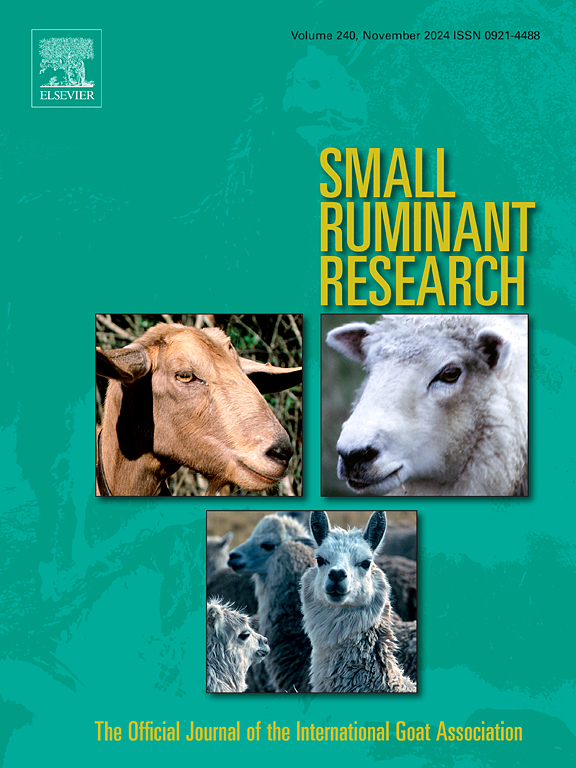饲粮中添加巴西棕榈蜡包被缓释尿素对羔羊采食量、摄食行为、选择性、瘤胃参数、生产性能和胴体性状的影响
IF 1.6
3区 农林科学
Q2 AGRICULTURE, DAIRY & ANIMAL SCIENCE
引用次数: 0
摘要
本研究制备了巴西棕榈蜡包被的缓释尿素微颗粒,并评价了其对羔羊采食量、摄食行为、选择性、瘤胃参数、生产性能和胴体性状的影响。首先,采用融合乳化的三种SRU配方的完全随机设计。根据壳(巴西棕榈蜡)和核(尿素)的比例制备了3种SRU [SRU50:50, SRU60:40和SRU70:30]并进行了表征。SRU70:30和SRU60:40的产率最高,平均为96和94 %,涂层效率也最高,接近99 %。其中,与SRU60:40和SRU70:30相比,SRU50:50的尿素保留率最高。SRU60:40的粗蛋白质(CP)含量比SRU70:30高13 %。微观分析显示了SRU配方的相似特征。差示扫描量热法表明熔点相似。因此,60:40的配方具有较好的性状,可用于羔羊饲粮中。试验选用平均体重为31.2 ± 4.8 kg的公羊(Santa Ines × Dorper) 50只,采用完全随机设计,分为5个处理,10个重复。对照处理为游离尿素(UFREE) 4.0 g,总干物质(DM)添加量为10、20、30和40 g/kg。SRUWAX不影响DM摄取量及其营养组分(P >; 0.05)。根据有效消耗的OM、EE和andform营养物质和饲粮粒度估算的饲粮选择性不受尿素供应形式的影响(P >; 0.05)。然而,由于SRUWAX的加入,TDN和NFC的浓度呈线性增加,有效消耗的CP浓度呈线性降低(P <; 0.05)。尿素供应形式(UFREE × SRUWAX)对羔羊的摄食行为、生产性能和胴体性状无显著影响(P >; 0.05)。SRUWAX添加量线性增加(P = 0.032)。瘤胃pH值与N-NH₃之间存在交互作用(P <; 0.05)。与其他处理相比,在40 g时加入SRUWAX使瘤胃pH接近中性。与SRUWAX相比,UFREE导致NH₃-N的峰值浓度更高,但与SRUWAX的水平没有差异。饲粮中添加SRUWAX可线性降低羔羊末重、平均日增重、热胴体重和饲料效率(P <; 0.01)。结果表明,巴西棕榈蜡是一种很好的尿素保护壳,最佳配比为60:40。然而,与使用游离尿素相比,在羔羊日粮中添加高达40 g/kg DM的SRUWAX并没有显著改善羔羊的增重或胴体特性。因此,选择一种控制尿素释放的羔羊育肥料应优先考虑经济效益。本文章由计算机程序翻译,如有差异,请以英文原文为准。
Effects of dietary supplementation with slow-release urea coated with carnauba wax on intake, ingestive behavior, selectivity, ruminal parameters, performance and carcass traits of lambs
This study developed slow-release urea microparticles coated by carnauba wax (SRUWAX), and evaluated their effect on intake, ingestive behavior, selectivity, ruminal parameters, performance, and carcass traits of lambs. Firstly, a completely randomized design with three SRU formulations through fusion-emulsification was adopted. Three SRU were produced [SRU50:50, SRU60:40 and SRU70:30 based on shell (carnauba wax) and core (urea) ratios] and characterized. SRU70:30 and SRU60:40 showed the highest yields averaging 96 and 94 %, also exhibiting the highest coating efficiencies with values close to 99 %. Among the formulations evaluated, SRU50:50 showed the highest urea retention percentage when compared to SRU60:40 and SRU70:30. The crude protein (CP) content of SRU60:40 was 13 % higher than that of SRU70:30. Microscopic analysis revealed similar characteristics among SRU formulations. Differential Scanning Calorimetry indicated that the melting points were similar. Therefore, the formulation 60:40 presented better traits, and it was used in the lamb’s diet. Fifty male lambs (Santa Ines × Dorper) weighting an average 31.2 ± 4.8 kg, were assigned to a completely randomized design consisting of five treatments with ten replications. The experiment included a control treatment containing 4.0 g of free urea (UFREE), and four SRUWAX inclusion levels: 10, 20, 30, and 40 g/kg of total dry matter (DM). SRUWAX did not affect (P > 0.05) the DM intake and its nutritional fractions. Diet selectivity estimates from the nutrients effectively consumed OM, EE, and aNDFom and dietary particle size were not influenced by the form of urea supply (P > 0.05). However, there was a linear increase on the concentrations of TDN and NFC and a linear reduction in the concentrations of CP effectively consumed due to the inclusion of SRUWAX (P < 0.05). The form of urea supply (UFREE × SRUWAX) did not affect (P > 0.05) the ingestive behavior, performance and carcass traits of the lambs. However, SRUWAX addition linearly increased (P = 0.032) the number of boli chewed/day. There was interaction effect (P < 0.05) between treatment and time after feeding to ruminal pH and N-NH₃. Including SRUWAX at 40 g stabilized ruminal pH closer to neutrality compared to other treatments. UFREE resulted in higher peak NH₃-N concentrations compared to SRUWAX, without difference to SRUWAX levels. SRUWAX inclusion in the diet linearly reduced (P < 0.01) the final weight, average daily gain (ADG), hot carcass weight, and feed efficiency of the lambs. Carnauba wax was confirmed as an excellent shell for urea protection, and the best proportion was 60:40 (shell: core). However, the addition of SRUWAX at levels up to 40 g/kg of DM to lamb diets did not result in significant improvements in weight gain or carcass characteristics compared to the use of free urea. Therefore, the selection of a urea-release controlled for lamb feedlot finishing should prioritize economic return.
求助全文
通过发布文献求助,成功后即可免费获取论文全文。
去求助
来源期刊

Small Ruminant Research
农林科学-奶制品与动物科学
CiteScore
3.10
自引率
11.10%
发文量
210
审稿时长
12.5 weeks
期刊介绍:
Small Ruminant Research publishes original, basic and applied research articles, technical notes, and review articles on research relating to goats, sheep, deer, the New World camelids llama, alpaca, vicuna and guanaco, and the Old World camels.
Topics covered include nutrition, physiology, anatomy, genetics, microbiology, ethology, product technology, socio-economics, management, sustainability and environment, veterinary medicine and husbandry engineering.
 求助内容:
求助内容: 应助结果提醒方式:
应助结果提醒方式:


